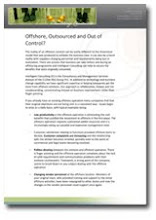
In the pursuit of fairness, HM Revenue & Customs are constantly reassessing and revising legislation, but unfortunately, ambiguities and loop holes are being exploited with the same pliancy and resolve.
It’s been found that some companies and employment businesses are using employment intermediaries to hide the fact that a number of their contractors are not, in fact, self-employed. This means they can engage workers without respecting employment rights and entitlements such as holiday pay, sick pay and pensions, thereby avoiding having to pay employers National Insurance.
In an attempt to reduce false self-employment, HMRC have set in place new legislation to make tax avoidance very difficult. As well as protecting contractors, HMRC’s legislation will make sure that businesses that follow the rules cannot be undercut by those avoiding their tax obligations.
As of 6th April 2015, it will be a legal requirement for all UK recruitment firms to submit quarterly reports to HMRC, informing them of the gross payments made to their contractors. The details must include the name, address and National Insurance number for each contractor. This includes all contractors who are either engaged via personal service companies, or via umbrella companies who haven’t been subject to PAYE reductions. Of course, your personal information is protected by the Data Protection Act 1998, so you can be absolutely assured that your information will be held securely. The law requires us to hold onto this information for at least three years.
Click here to read a more detailed account of HMRC’s guidance.If you are yourself a contractor, then this revision to the Income Tax (Earnings and Pensions) Act, otherwise known as ITEPA, directly affects you.
Are you a contractor? Then you need to know this…
If you are a contractor with us, please send your name, address and NI number to ITEPA@rsg-plc.com by Friday 10th April. If you have any questions, please feel free to call us on 0117 915 0367, and our dedicated legal team will be more than happy to help. You would also be required to provide this information should you work through an umbrella company and are paid PAYE.
If your contract with us ends before the 6th April then you don’t need to worry about this, but if your contract is extended then this information will be required.
Do you run a personal service company (PSC)?
If your contract with us ends before the 6th April then you don’t need to worry about this, but if your contract is extended then this information will be required.
Do you run a personal service company (PSC)?
The only reason you may be required to submit more than just your name, address and NI number would be if you run a personal service company (PSC) which employs more than one worker (this includes sub-contractors), then you will act as an intermediary which will make it your legal responsibility to report directly to HMRC.
Click here to read the full legislation.We will always keep you informed of any and all useful information. Legislative changes often set people on edge, but not to worry! It’s comforting to know that HMRC are keeping their eyes peeled.
Click here to read the full legislation.We will always keep you informed of any and all useful information. Legislative changes often set people on edge, but not to worry! It’s comforting to know that HMRC are keeping their eyes peeled.









